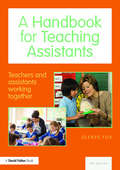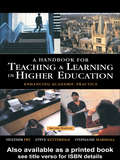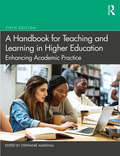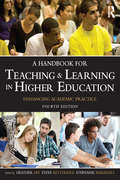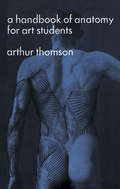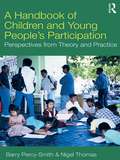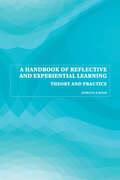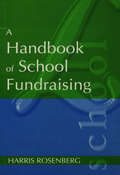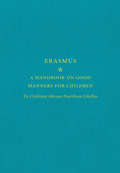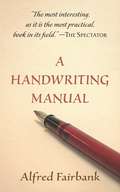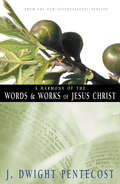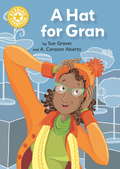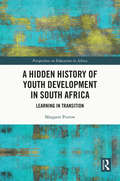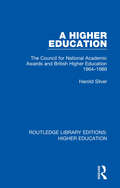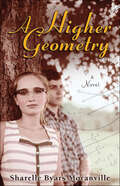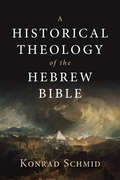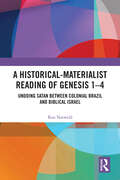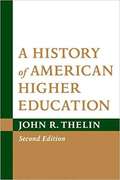- Table View
- List View
A Handbook for Teaching Assistants: Teachers and assistants working together
by Glenys FoxThis revised new edition provides essential guidance for all teaching assistants, especially those who are new to the job, and to the teachers working with them. Glenys Fox details the roles and responsibilities of the TA, as well as providing helpful advice on how to best support the teacher, the pupil, the curriculum and the school. This practical handbook will bring experienced TAs up to date on changes to National educational guidance, including changes in the National Curriculum, assessment, and the Special Educational Needs framework. This text enables the assistant and the teacher to work together more effectively in supporting and promoting the progress of children and young people. Written in light of recent research and updates in legislation, this guide will ensure that: teaching assistants know what to expect of colleagues, and vice versa pupils are given the best possible support by teaching assistants who understand their needs teaching assistants and teachers are able to work together effectively to support the learning of all children, especially children who have special educational needs and disabilities any training received is relevant and helpful. A Handbook for Teaching Assistants is an ideal textbook for training, as well as a useful classroom handbook for teaching assistants working in early years, primary and secondary settings.
A Handbook for Teaching and Learning in Higher Education: Enhancing Academic Practice
by Heather Fry Stephanie Marshall Steve KetteridgeFirst Published in 2002. Routledge is an imprint of Taylor & Francis, an informa company.
A Handbook for Teaching and Learning in Higher Education: Enhancing Academic Practice
by Stephanie MarshallFocused on developing professional academic skills for supporting and supervising student learning and effective teaching, the fifth edition of A Handbook for Teaching and Learning in Higher Education recognises the complex demands of teaching, research, scholarship and academic management in higher education institutions. Fully updated to reflect changes in practice and policy, this new edition has been written to enhance excellence in teaching and learning design and support all involved in facilitating a world-class inclusive education. Offering plentiful and rich practical advice, this rigorous and sound introduction to the basics of teaching and learning in higher education draws together a large number of expert authors and a range of global case studies. A definitive guide for anyone working in higher education, this edition: Offers new chapters covering an inclusive curriculum, the importance of student well-being and the scholarship of teaching and learning Considers the impact of technological changes on policy and practice Discusses the use of digital learning environments Explores how best to engage students in their disciplines and embed skills for employability The ultimate guide to support all those involved in providing student learning of the highest quality, A Handbook for Teaching and Learning in Higher Education is essential reading for all new lecturers. It will be particularly useful for anyone taking an accredited course in teaching and learning in higher education, as well as more experienced lecturers who wish to improve their teaching practice.
A Handbook for Teaching and Learning in Higher Education: Enhancing academic practice
by Heather Fry Stephanie Marshall Steve Ketteridge Steven KetteridgeThis entirely new edition of a very successful book focuses on developing professional academic skills for supporting and supervising student learning and effective teaching. It is built on the premise that the roles of those who teach in higher education are complex and multi-faceted. A Handbook for Teaching and Learning in Higher Education is sensitive to the competing demands of teaching, research, scholarship, and academic management. The new edition reflects and responds to the rapidly changing context of higher education and to current understanding of how to best support student learning. Drawing together a large number of expert authors, it continues to feature extensive use of case studies that show how successful teachers have implemented these ideas. It includes key topics such as student engagement and motivation, internationalisation, employability, inclusive strategies for teaching, effective use of technology and issues relating to postgraduate students and student retention. Part 1 explores a number of aspects of the context of UK higher education that affect the education of students, looking at the drivers of institutional behaviours and how to achieve success as a university teacher. Part 2 examines learning, teaching and supervising in higher education and includes chapters on working with diversity, encouraging independent learning and learning gain. Part 3 considers approaches to teaching and learning in different disciplines, covering a full range including arts and humanities, social sciences, experimental sciences through to medicine and dentistry. Written to support the excellence in teaching and learning design required to bring about student learning of the highest quality, this will be essential reading for all new lecturers, particularly anyone taking an accredited course in teaching and learning in higher education, as well as those experienced lecturers who wish to improve their teaching practice. Those working in adult learning and educational development will also find the book to be a particularly useful resource. In addition it will appeal to staff who support learning and teaching in various other roles.
A Handbook of Anatomy for Art Students (Dover Anatomy For Artists Ser.)
by Arthur ThomsonSkeletal structure, muscles, heads, special features. Exhaustive text, anatomical figures, undraped photos. Male and female. 337 illustrations.
A Handbook of Children and Young People's Participation: Perspectives from Theory and Practice
by Nigel Thomas Barry Percy-SmithA Handbook of Children and Young People's Participation brings together key thinkers and practitioners from diverse contexts across the globe to provide an authoritative overview of contemporary theory and practice around children’s participation. Promoting the participation of children and young people – in decision-making and policy development, and as active contributors to everyday family and community life – has become a central part of policy and programme initiatives in both majority and minority worlds. This book presents the most useful recent work in children’s participation as a resource for academics, students and practitioners in childhood studies, children’s rights and welfare, child and family social work, youth and community work, governance, aid and development programmes. The book introduces key concepts and debates, and presents a rich collection of accounts of the diverse ways in which children’s participation is understood and enacted around the world, interspersed with reflective commentaries from adults and young people. It concludes with a number of substantial theoretical contributions that aim to take forward our understanding of children’s participation. The emphasis throughout the text is on learning from the complexity of children’s participation in practice to improve our theoretical understanding, and on using those theoretical insights to challenge practice, with the aim of realising children’s rights and citizenship more fully.
A Handbook of Reflective and Experiential Learning: Theory and Practice
by Jennifer A. MoonThis handbook acts as an essential guide to understanding and using reflective and experiential learning - whether it be for personal or professional development, or as a tool for learning.It takes a fresh look at experiential and reflective learning, locating them within an overall theoretical framework for learning and exploring the relationships between different approaches.As well as the theory, the book provides practical ideas for applying the models of learning, with tools, activities and photocopiable resources which can be incorporated directly into classroom practice.This book is essential reading to guide any teacher, lecturer or trainer wanting to improve teaching and learning.
A Handbook of School Fundraising
by Rosenberg, HarrisThis title aims to guide the reader through the maze of statutory and other potential funding sources such as government departments, local education authorities or organizations with a specific interest or remit to help schools pursue avenues towards achieving their goals.
A Handbook of Techniques for Formative Evaluation: Mapping the Students' Learning Experience
by John Cowan Judith GeorgeThis handbook provides all those teaching in higher and further education with a reference on how to develop and use a "toolkit" which is capable of exploring and assessing all the relevant aspects of their students' learning. It discusses how readers can assess their own teaching quality.
A Handbook on Good Manners for Children: De Civilitate Morum Puerilium Libellus
by ErasmusWhen did you last tell your children to put their hand over their mouth when they yawn? When did you last suggest that when they are introduced to someone they should shake hands firmly and look them in the eye? Do you suggest that they should wait until everyone is served before they eat rather than hoover up the best bit for themselves? Do you demand that your young daughter dress decorously lest she elicit outraged looks? Do you think that the children of today have disgraceful manners? Unlike, of course, when you were young ... Well, that's certainly what Erasmus of Rotterdam thought in 1530 when he published De Civilitate Morum Puerilium: A Handbook on Good Manners for Children. He felt that learning good manners was crucial to a child's upbringing, and that the uncouth and ill-disciplined behaviour around him demanded a new kind of book. After all, as William of Wykeham memorably said in the 1350s, 'Manners maketh man'. A Handbook on Good Manners for Children is considered to be the first treatise in Western Europe on the moral and practical education of children. It was a massive bestseller - indeed the biggest-selling book of the sixteenth century - going into 130 editions over 300 years and being translated into 22 languages within ten years of its publication. In it, Erasmus concerns himself with matters such as how to dress, how to behave at table, how to converse with one's elders and contemporaries, how to address the opposite sex and much else. For example: Table Manners 'It's just as rude to lick greasy fingers as it is to wipe them on your clothing, Use a cloth or napkin instead.''Some people, no sooner than they've sat down, immediately stick their hands into the dishes of food. This is the manner of wolves.' 'Making a raucous noise or shrieking intentionally when you sneeze, or showing off by carrying on sneezing on purpose, is very ill-mannered.''To fidget around in your seat, and to settle first on one buttock and then the next, gives the impression that you are repeatedly farting, or trying to fart.' The advice is as relevant today as it was 500 years ago.
A Handbook to Old Testament Exegesis
by William P. BrownDesigned for both Hebrew and non-Hebrew students, A Handbook to Old Testament Exegesis offers a fresh, hands-on introduction to exegesis of the Old Testament. William P. Brown begins not with the biblical text itself but with the reader, helping students to identify their own interpretive lenses before engaging the biblical text. Brown guides the student through a wide variety of interpretive approaches, including modern methodologies--feminist, womanist, Latino/a, queer, postcolonial, disability, and ecological approaches--alongside more traditional methods. This allows students to critically reflect on themselves as bona fide interpreters. While covering a wide range of biblical passages, Brown also highlights two common biblical texts throughout the work to help show how each interpretive approach highlights different dimensions of the same texts. Students will appreciate the value of an empathetic inquiry of Scripture that is both inclusive of others and textually in-depth.
A Handwriting Manual
by Alfred Fairbank"This famous manual . . . should be read by all those professing the slightest interest in lettering, writing, or the graphic arts." — Printing World"Despite the spate of publications on this subject, this one remains far and away the best." — Society of Industrial Artists JournalThis classic introduction presents the fundamentals behind every aspect of the art of penmanship, from the necessary equipment to the best techniques. Written by an expert calligrapher whose books were widely used in schools, it offers an essential guide to those who practice or teach lettering and graphic design.Clearly illustrated with numerous examples and diagrams, the text begins with the development and characteristics of italic and the essentials of good penmanship: legibility, beauty, unity, speed, expedience, freedom, and control. Subsequent chapters explain the tools of penmanship and their use: pens and penholders, pencils, felt-tipped pens, chalks, paper, and ink as well as hand movements, pressure, and touch. Discussions and examples of technique focus on strokes, joins, rhythms, angularity slant, and spacing in addition to how to write capitals, minuscules, numerals, stops, and contractions.
A Harmony of the Words and Works of Jesus Christ
by J. Dwight PentecostThe goal of this volume is to help you know Jesus better by getting a clearer picture of him through the four Gospels—the books that directly depict his life, his ministry, and his heart. Scripture is set with Scripture in chronological order, revealing the harmony of the biblical accounts and bringing the person of Jesus into greater focus. Featuring harmonized Bible texts from the New International Version, this book first introduces and then follows the identical outline of the life of Christ used in The Words and Works of Jesus Christ by J. Dwight Pentecost. This simple, logical presentation of the complete parallel text with the outline greatly simplifies your study of Christ's life. A Harmony of the Words and Works of Jesus Christ is ideal for use with The Words and Works of Jesus Christ and makes an outstanding parallel Scripture text for any study of the Gospels or the life of Christ.
A Hat for Gran: Independent Reading Yellow 3 (Reading Champion #466)
by Sue GravesThis story is part of Reading Champion, a series carefully linked to book bands to encourage independent reading skills, developed with Dr Sue Bodman and Glen Franklin of UCL Institute of Education (IOE)Gran really needs a new hat. She visits the hat shop, but it is hard to find one that is just right for her!Reading Champion offers independent reading books for children to practise and reinforce their developing reading skills.Fantastic, original stories are accompanied by engaging artwork and a reading activity. Each book has been carefully graded so that it can be matched to a child's reading ability, encouraging reading for pleasure.
A Hi Peleni Nambu Buku ya Mudyondzi Giredi 11: UBC Uncontracted
by R Khumalo M M Usinga T Sono G G MtebuleYi angarhela swilaveko swa CAPS hi xiyimo xa le henhla no tsariwa hi vatsari lava nga ni ntokoto. Yi na swifaniso na migingiriko ya xiyimo xa le henhla ku antswisa mimbuyelo no hlohlotela vadyondzi.
A Hidden History of Youth Development in South Africa: Learning in Transition (Perspectives on Education in Africa)
by Margaret PerrowDrawing on two decades of interviews and ethnographic fieldwork (1998–2018), this book presents a unique and multi-faceted history of youth development in South Africa through the lens of a South African non-governmental organization (NGO) prominent in youth development from the mid-1980s until 2008. The book weaves history, ethnography, and discourse analysis to contextualize the Joint Enrichment Project (JEP) in the politics and history of South African education. It examines JEP’s role leading up to and during South Africa’s transition to democracy, its work and influence in post-apartheid South Africa, and the continued relevance of its legacy to contemporary initiatives seeking to address youth development and social justice. While JEP repeatedly repositioned itself as an organization, from fighting the effects of apartheid on young people to becoming a potential partner with the new African National Congress (ANC)-led government, its most significant role may have been to reposition people. After tracing JEP’s twenty-year history, the book focuses on the participants in a 1998 Youth Work Scheme, exploring their learning experiences and the program’s immediate impact on their lives. It then revisits these participants twenty years later in 2018, analyzing their life trajectories after JEP and comparing them with the life trajectories of former JEP staff over the same period—shedding light on broader patterns of socio-economic reproduction and change in the country. The book concludes with a discussion of a perennial paradox facing youth development institutions. This book will be of great interest to academics, researchers and post-graduate students in the fields of education, international development, anthropology, and African studies.
A Higher Dimension: Enter a World of Prophecy, Miracles, and Glory
by Ryan LeStrangeYou weren&’t born into a season. You were born into a dimension. This book will show you what it means to function in the realm of God&’s kingdom and how you can demonstrate its power. A dimension is not a time but a space, a place, and a location. The Bible speaks of the kingdom of God as a realm. By becoming Christians, we move into the space of the kingdom. And as we come into proper understanding of the weight and reality of the kingdom, we are able to subdue the forces of hell at work in the earth realm. &“For He rescued us from the domain of darkness, and transferred us to the kingdom of His beloved Son, in whom we have redemption, the forgiveness of sins&” (Col. 1:13–14, NASB). We have been translated or transferred from one place to another. We have been relocated from one realm to another. We have moved from one dimension to another. Through His sacrifice on the cross Jesus paid our debts fully and transferred us from under the authority of darkness into His marvelous power and rule. We are now fully active citizens of the kingdom, and we are called to dwell in a new dimension. When we function from this dimension, we demonstrate the power of the kingdom and transform the space around us. This book will encourage believers to access the fullness of the power and authority that is available to them as ambassadors of the kingdom of God by helping them to understand the nature of this dimension and their position in it. Other Books by Ryan LeStrange: The Jochebed Anointing ISBN: 978-1-62999-645-5The Power of the Double ISBN: 978-1-62999-663-9Hell's Toxic Trio ISBN: 978-1-62999-488-8 Supernatural Access ISBN: 978-1-62999-168-9
A Higher Education: The Council for National Academic Awards and British Higher Education 1964-1989 (Routledge Library Editions: Higher Education #29)
by Harold SilverOriginally published in 1990, A Higher Education was commissioned by the Council for National Academic Awards to commemorate its silver jubilee. The book covers the history of a period of rapid expansion in higher education outside the universities, mirrored in the growth and development of the CNAA. The Council was established with the role of awarding degree courses in polytechnics and colleges, and so its successes and strengths – as well as its problems and difficulties – reflect very closely the preoccupations and events of higher education since 1964. The book describes how the CNAA helped to broaden the range of degree courses beyond the traditional subjects, the way it maintained and enhanced standards in a swiftly changing academic world, and its part in widening access to higher education. The book draws on interviews as well as extensive records of the CNAA and some of its institutions.
A Higher Geometry: A Novel
by Sharelle Byars MoranvilleAnna loves math, and her boyfriend, Mike. Will she have to choose between them?Anna Conway sometimes wishes her relationships would come as easy to her as math does. A natural math talent, Anna is at odds with what's expected of her as a teenager in the 1950s. While Anna aspires to leave her small town for college to study mathematics, her parents want her to follow the more traditional path of getting married and starting a family. Anna's never really thought of dating before, but when she meets Mike, their relationship takes off and goes further than she'd ever expected. Now it's up to Anna to make her future happen. But how will she choose? In beautiful prose, Sharelle Byars Moranville explores the importance of believing in dreams in order to make a difference.A Higher Geometry is a 2007 Bank Street - Best Children's Book of the Year.
A Historical Theology of the Hebrew Bible
by Konrad SchmidIn this meticulously researched study, Konrad Schmid offers a historical clarification of the concept of “theology.” He then examines the theologies of the three constituent parts of the Hebrew Bible—the Torah, the Prophets, and the Writings— before tracing how these theological concepts developed throughout the history of ancient Israel and early Judaism.Schmid not only explores the theology of the biblical books in isolation, but he also offers unifying principles and links between the distinct units that make up the Hebrew Bible. By focusing on both the theology of the whole Hebrew Bible as well as its individual pieces, A Historical Theology of the Hebrew Bible provides a comprehensive discussion of theological work within the Hebrew Bible.
A Historical Theology of the Hebrew Bible
by Konrad SchmidIn this meticulously researched study, Konrad Schmid offers a historical clarification of the concept of &“theology.&” He then examines the theologies of the three constituent parts of the Hebrew Bible—the Torah, the Prophets, and the Writings— before tracing how these theological concepts developed throughout the history of ancient Israel and early Judaism.Schmid not only explores the theology of the biblical books in isolation, but he also offers unifying principles and links between the distinct units that make up the Hebrew Bible. By focusing on both the theology of the whole Hebrew Bible as well as its individual pieces, A Historical Theology of the Hebrew Bible provides a comprehensive discussion of theological work within the Hebrew Bible.
A Historical-Materialist Reading of Genesis 1-4: Undoing Satan between Colonial Brazil and Biblical Israel
by Ron NaiweldThis book offers a historical-materialist reading of the opening chapters of the book of Genesis in an attempt to revive their potential to engage people in truthful discussions about power and pleasure.For the past two millennia, biblical stories have been told and discussed in countless settings; whether one lives in Europe or in a country that was colonized by Europeans, the biblical symbolic universe remains present. This book offers a method to explore the social and political meanings of its most theological content by visiting two historical settings in which biblical modes of expression intersected with the demands of an economic-political process: Jerusalem and its province during the Persian period (5th–4th centuries bce) and Brazil of the early colonial period (16th century ce). Though distant in time and space, both were moments of comparable transformation: individuals with financial resources and military power arrived from the East to seize control over lands and means of production, subjugating the population to a distant king. By turning to these two historical settings, Ron Naiweld examines how the narratives of Genesis resonated in these environments, how they were used to legitimize imperial power structures, and how they opened these structures to scrutiny. The volume is part of a larger trend of reading the Bible with a historical-materialist approach that allows us to grasp the power of its symbolic universe to inspire both utopia and barbarism, especially in colonial contexts.This book is suitable for students and scholars interested in the biblical symbolic universe and Jewish and Christian history. It is also of interest to those working on the history of Brazil, comparative literature, and the intersection of religion, economy, and politics.
A History Of American Higher Education
by John R. ThelinColleges and universities are among the most cherished―and controversial―institutions in the United States. In this updated edition of A History of American Higher Education, John R. Thelin offers welcome perspective on the triumphs and crises of this highly influential sector in American life. Thelin’s work has distinguished itself as the most wide-ranging and engaging account of the origins and evolution of America's institutions of higher learning. This edition brings the discussion of perennial hot-button issues such as big-time sports programs up to date and addresses such current areas of contention as the changing role of governing boards and the financial challenges posed by the economic downturn.
A History Of Christian Education
by James E. Reed Ronnie ProvostOurs is an age of rapid change. What is fashionable comes and goes more quickly than ever before. In a world of such rapid change, it's essential to know who you are--to know where you come from, to have your roots go deep. Walking through this book is like going to a large family reunion and meeting for the first time some relatives you didn't know you had. Here in all of its richness and diversity is your family of faith. Of course, the roots of Christian education go deep into the Hebrew heritage. In many ways, Christian education is an extension of Hebrew education.
